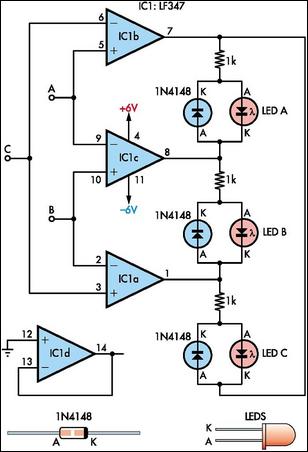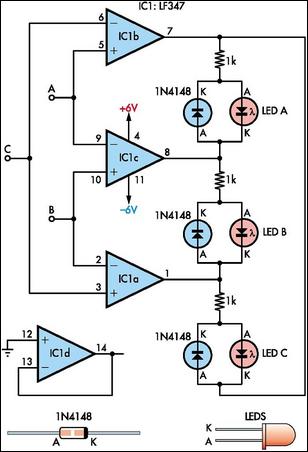
Five-step voltage-level indicator

This circuit offers a visual representation of the input analog voltage level. It features a high input impedance at pin 8 and open-collector outputs that can sink up to 40 milliamperes. It is designed to drive a linear array of 5 LEDs, allowing for a five-step indication of the voltage level. The voltage at the analog input should be within the range of zero to approximately one volt and must not exceed eight volts.
The circuit utilizes a high-impedance operational amplifier configured as a voltage follower to ensure minimal loading on the input signal. The output from the op-amp feeds into a comparator circuit, which compares the input voltage against predefined reference levels corresponding to each LED in the array. The reference voltages can be set using a resistor divider network connected to a stable reference voltage source.
When the input voltage reaches specific thresholds, the comparator outputs transition, activating the open-collector outputs. These outputs are connected to the anodes of the LEDs, while the cathodes are tied to ground through current-limiting resistors. This configuration allows the circuit to illuminate the appropriate number of LEDs based on the input voltage level, providing a clear visual indication.
To ensure the circuit operates correctly, it is crucial to maintain the input voltage within the specified range. If the input voltage exceeds eight volts, it may lead to undesired behavior or damage to the components. Therefore, voltage clamping devices such as Zener diodes may be incorporated to protect the input stage from overvoltage conditions.
In summary, this circuit effectively visualizes analog voltage levels through a straightforward LED array, combining high input impedance, open-collector outputs, and adjustable reference voltages to create an intuitive and informative display.This circuit provides a visual indication of the input analog voltage level. It has a high input impedance at pin 8 and open-collector outputs capable of sinking up to 40 milliam-peres. It is suitable for driving a linear array of 5 LEDs to indicate the level is 5 steps The voltage at the analog input should be in the range of zero to approximately one volt and should never exceed eight volts.
The circuit utilizes a high-impedance operational amplifier configured as a voltage follower to ensure minimal loading on the input signal. The output from the op-amp feeds into a comparator circuit, which compares the input voltage against predefined reference levels corresponding to each LED in the array. The reference voltages can be set using a resistor divider network connected to a stable reference voltage source.
When the input voltage reaches specific thresholds, the comparator outputs transition, activating the open-collector outputs. These outputs are connected to the anodes of the LEDs, while the cathodes are tied to ground through current-limiting resistors. This configuration allows the circuit to illuminate the appropriate number of LEDs based on the input voltage level, providing a clear visual indication.
To ensure the circuit operates correctly, it is crucial to maintain the input voltage within the specified range. If the input voltage exceeds eight volts, it may lead to undesired behavior or damage to the components. Therefore, voltage clamping devices such as Zener diodes may be incorporated to protect the input stage from overvoltage conditions.
In summary, this circuit effectively visualizes analog voltage levels through a straightforward LED array, combining high input impedance, open-collector outputs, and adjustable reference voltages to create an intuitive and informative display.This circuit provides a visual indication of the input analog voltage level. It has a high input impedance at pin 8 and open-collector outputs capable of sinking up to 40 milliam-peres. It is suitable for driving a linear array of 5 LEDs to indicate the level is 5 steps The voltage at the analog input should be in the range of zero to approximately one volt and should never exceed eight volts.





